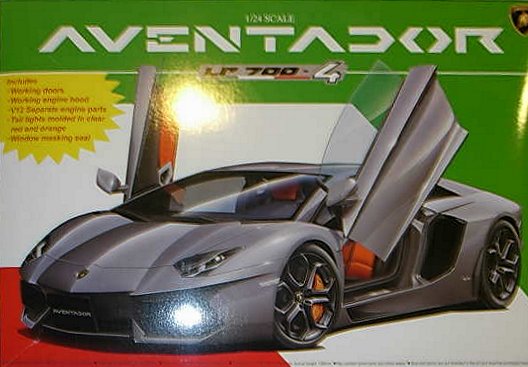Lamborghini Aventador LP700-4
Lamborghini introduced the Aventador in 2011 as the replacement for the Marcielago. Aoshima introduced its 1/24 scale version in 2012 and the model is every bit as cool-looking as the real thing. Aoshima accurately captured the stealth jet fighter proportions of the one-to-one car.
The model comes packaged in separate bags for the different trees. The body parts are molded in white plastic, the interior parts in gray, and the chassis in black. The wheels, headlight/taillight bezels, exhaust, and a couple of other pieces are molded in a satin chrome finish. There are painting mask for the windshield and side windows, and all of the clear parts are packaged separately. The taillights are molded in clear red, so no painting needed. The instruction sheet, mostly, is clear and easy to follow.
This is basically a curbside model, so the build starts with the chassis. The suspension is very simple; thankfully, you don’t see much of it due to the full-length flat belly pan. I suspect this is true on the one-to-one car as well. What you get is separate upper control arms, pushrods, and tie rods for the poseable front wheels. The brakes have good disc and caliper detail with a choice of black or white Lamborghini decals. As I said, the wheels are chrome and differently sized for front and rear. The tires have good tread and sidewall detail. The tread patterns are directional, so pay attention to which side they go on. The chassis is quick build and sets flat on all four wheels.
What there is of the engine is separate from the engine bay, so painting is easy and it is well detailed. As part of the engine bay build up, you have the rear shock absorbers. In step 10, the instruction sheet calls for decal 13 to be placed on the shocks – it should be decal 36. Also in step eleven 11, pay attention to the Lamborghini script on the valve covers; it should read to the outside, not to the inside as the instruction sheet shows.
When finished, the interior is very nice. It consists of the floor pan; separate two-piece dash, bucket seats, center console, steering wheel/column, separate door panels, and headliner. The gauges are decals that mount to the back of a clear panel. You have a choice of two displays. Everything fits nicely, and when detail painted really comes alive.
The body is composed of several different panels. Some of the panels, such as the rocker panels, can be fitted before painting. The large air ducts along the upper side of the body can be positioned open or closed and the wing can be mounted up or down. The large air intakes along the side are separate, which makes painting them much easier. There are large intakes in the front and rear fascia as well. These intakes, as well as smaller ones in the rocker panes, are covered with a screen. Aoshima chose to represent this screen mesh with a decal applied to a clear part that fit into the opening for the intake. The decal looks good on the clear part and the whole thing fits in the opening well. The problem is, once the body is on the chassis, the clear part is reflective and looks more like a window than an opening for an air intake. I decided to omit these parts and use some styrene screen I had sitting in my parts box. It looks much better. The painting masks for the windows fit perfectly, as do the windows to the body. The doors are made to open. The hinge mechanism is somewhat complicated and flimsy, and the door operation is sloppy at best; however, when closed, the doors fit the body well, as do all the panels. I resisted the temptation to paint my Aventador matte black like the box art, though I think it looks really mean in that color. I chose to go with a matte orange instead.
The model was a joy to build. All of the parts fit well, and there is very little flash or sink marks. The ejection pin marks are mostly hidden – the rear deck lid being the exception, and those will need to be sanded or filled. The detail on this model is exceptional and the proportions appear to be dead-on. There are some tricky parts, particularly the door and rear deck lid hinge assembly, but I highly recommend this model to anyone looking for a world-class super car to put on their shelf.
I would like to thank Dragon Models USA and IPMS for the opportunity to review this model.










Comments
Add new comment
This site is protected by reCAPTCHA and the Google Privacy Policy and Terms of Service apply.
Similar Reviews